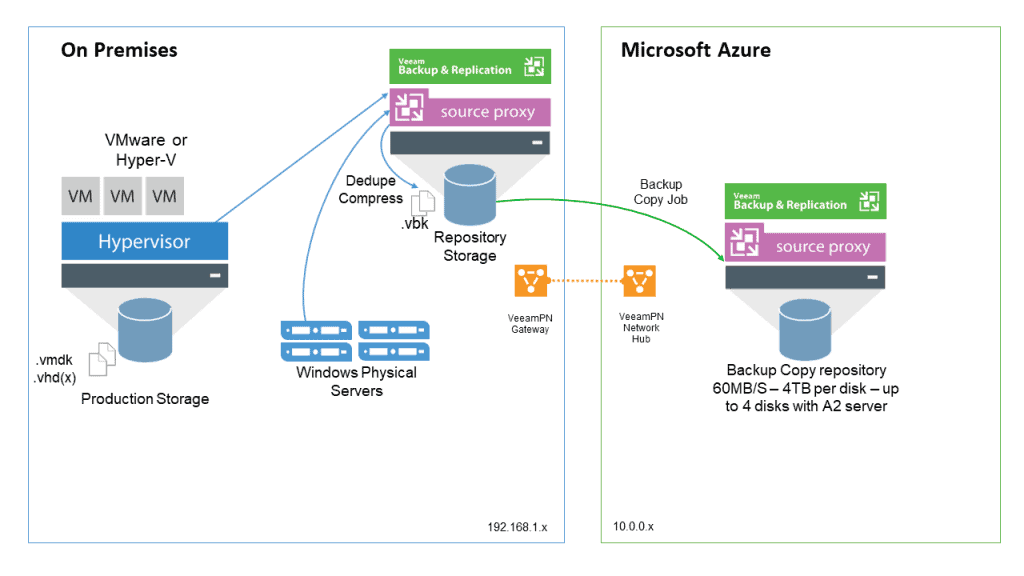 Greetings friends, every day it is more common to move workloads to Microsoft Azure, or at least to have planned a certain level of Disaster Recovery to Microsoft Azure in case of a complete shutdown of our main data center, to be able to restore those most urgent applications for users or customers, reducing service downtime.
Greetings friends, every day it is more common to move workloads to Microsoft Azure, or at least to have planned a certain level of Disaster Recovery to Microsoft Azure in case of a complete shutdown of our main data center, to be able to restore those most urgent applications for users or customers, reducing service downtime.
Veeam has a number of specific products for moving workloads to Microsoft Azure, easily and fully integrated into the Veeam Backup & Replication console itself.
The main functionality, available since March 2016, is called Direct Restore to Microsoft Azure, and although it used to come as a separate application it is now available on the Veeam Backup & Replication console itself to help with its integration.
Infrastructure topology
I would like to show you this diagram (thanks to Allan Hammond for his help with the diagram) so that we can understand Veeam’s workflow between the local data center and Microsoft Azure and vice versa:
 In this way we get our backups to be done in our datacenter as usual, making a backup copy job to Microsoft Azure, and once there the jobs can perform the Direct Restore to Microsoft Azure in case of failure in our local datacenter, for example here:
In this way we get our backups to be done in our datacenter as usual, making a backup copy job to Microsoft Azure, and once there the jobs can perform the Direct Restore to Microsoft Azure in case of failure in our local datacenter, for example here:
 Once we recover our primary datacenter, it’s time to bring the backups back, and for that we will use the following method, supported from Veeam Backup & Replication v9.5 U3, using all the power of Veeam Agent Management, which not only serves for physical computers, but also to protect instances in Cloud, as is the case here:
Once we recover our primary datacenter, it’s time to bring the backups back, and for that we will use the following method, supported from Veeam Backup & Replication v9.5 U3, using all the power of Veeam Agent Management, which not only serves for physical computers, but also to protect instances in Cloud, as is the case here:
System Requirements
In order to elaborate this procedure we will have to have all the following at software level ready:
- A valid license of Veeam Backup & Replication v9.5U3 for the regular Datacenter.
- If we have a Datacenter to Azure upstream line of less than 100mbps you can choose to use WAN Accelerator, but this functionality requires Veeam Enterprise Plus.
- A valid 0-socket license of Veeam Backup & Replication v9.5U3 for Microsoft Azure can be ordered from Veeam by opening a support ticket.
- A valid Microsoft Azure subscription to create VMs, Storage, Networking, etc.
Comments about the selected workflow
One of the advantages that this process has, vs. a pure DR, is that in Microsoft Azure we only pay for the resources that the VBR + disk consume, plus the Veeam PN in case we use it, and when there is a contingency, is when we will use the Direct Restore to Microsoft Azure and create the instances, increasing of course our Azure invoice, but always knowing that is temporary.
If we use a custom DR where instances are created directly, we would be paying for Virtual Machines + disk, etc. that are turned off most of the time.
For me this is a considerable advantage. I would like to mention that if we want to further reduce the RTO one of the best solutions today is to use any of Veeam’s VCSP Partners instead of Microsoft Azure, the advantages are the following:
- By performing a DR to a VCSP, we can perform a Full Site Failover ourselves.
- By performing a DR to a VCSP, we can perform a Partial Site Failover ourselves.
- Of course it is always possible to failback and move the workload to the source datacenter without further interruption.
The good thing is to have multiple options, and although using a VCSP is the most complete at the DR level, for now, it is true that this series of blog posts is about the process of moving workloads to Microsoft Azure, I hope you like it, and I am sure you will find it useful.
I would like to leave you the list of articles that we will be seeing throughout the series:
- Backup and restore workloads to Microsoft Azure – Introduction
- Backup and restore workloads to Microsoft Azure – Connectivity between our Datacenter and Microsoft Azure
- Backup and restore workloads to Microsoft Azure – Deploy Veeam Backup & Replication in Microsoft Azure
- Backup and restore workloads to Microsoft Azure – Configuration in our Datacenter for backup to Microsoft Azure
- Backup and restore workloads to Microsoft Azure – Restoring Microsoft Azure, from Microsoft Azure
- Backup and restore workloads to Microsoft Azure – Migrate workloads from Microsoft Azure to our Datacenter


[…] por Jorge de la CruzEscrito en 18 March, 201818 March, 2018 Read it in English […]